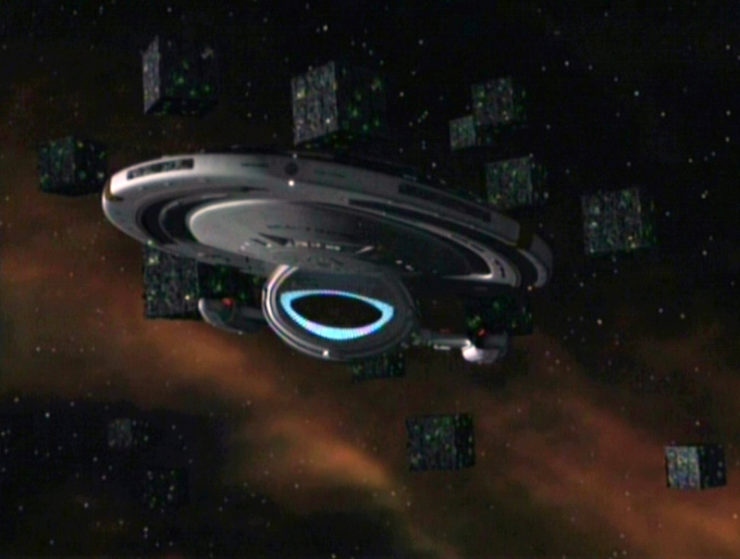“Scorpion” (Part 1)
Written by Brannon Braga & Joe Menosky
Directed by David Livingston
Season 3, Episode 26
Production episode 168
Original air date: May 21, 1997
Stardate: 50984.3
Captain’s log. We open with two Borg Cubes. They’re doing their usual shtick about how resistance is futile and you’ll be assimilated, and all that jazz that we’ve been hearing since “The Best of Both Worlds,” but the recitation is cut off mid-word by a blast that annihilates both cubes.
Voyager is starting to approach Borg space, which they learned when one of the long-range probes they sent ahead of their position found a Borg Cube and was destroyed.
This is the scariest part of their journey home, as they have to fly through a large swath of space that is controlled by the Borg. They’ve been prepping for this for the last several months, ever since they came across the first signs of Borg activity in the Nekrit Expanse.
Before the Borg destroyed it, the probe found a small strip of Borg space that is completely free of Borg ships, which they’ve nicknamed “the Northwest Passage,” after the sea route that runs between the northern part of North America and the Arctic. The plan is to go through that passage as fast as possible. Tuvok says that weapons are being retuned to rapidly modulate through upper EM frequencies, though that isn’t likely to stymie the Borg for long. Kim has set up long-range sensors to specifically look for transwarp signatures.
Buy the Book


Remote Control
The EMH and Kes have been studying the Borg corpse they retrieved from the inactive Borg Cube in the Nekrit Expanse. At this point, the EMH has figured out how assimilation works: nanoprobes are injected into a living being through indestructible needles that can seemingly penetrate any organic material. The nanoprobes immediately attack the blood cells. He’s working now on a way to at least slow it down—he has no idea how to entirely stop it, as the nanoprobes are too robust.
Kes gets a telepathic vision of multiple dead Borg piled on top of each other. It’s the first of several visions. Tuvok helps her deal with this psionic onslaught.
Kim detects fifteen Borg vessels all heading right for them. The ship goes to red alert—
—but then they shoot right past Voyager. One cube pauses to quickly scan them, then rejoins the others for the “run away!” maneuver.
The notion of the Borg running is insane, to say the least. Janeway reads over the logs of other Starfleet vessels that encountered the Borg, including the Enterprise and the Endeavour. Chakotay reassures her that the crew will be behind her, and that she’s not alone, even though she thinks she is.
Tuvok calls Janeway and Chakotay to the bridge. The fifteen cubes that blew past them are now unmoving and inactive. Janeway has Paris set a course, and they find that all fifteen cubes have been destroyed. The only life sign is a biological entity attached to one piece of hull.
Chakotay, Tuvok, and Kim beam over. They find a ton of Borg corpses, including one pile of them that looks exactly like one of Kes’ visions. Chakotay and Tuvok go to investigate the biological entity while Kim tries to download the Borg tactical database.
Kes feels the presence of the aliens that attacked the Borg—she sees a premonition of Kim screaming in agony and tells Janeway to get the away team out. She also tells Janeway that they shouldn’t fear the Borg—they should fear this new species, who transmit a message to Kes: “The weak must perish.”
One of these guys attack the away team, wounding Kim and infecting him with a disease. They manage to beam back before anyone else is hurt. While the EMH tries and fails to treat Kim, Torres learns that the bad guys are referred to by the Borg as “Species 8472.” The Borg can’t assimilate them, and therefore know nothing about them.
However, they now know the reason why the Borg avoid the Northwest Passage: it’s filled with quantum singularities (which everyone thought was why the Borg avoided it) which 8472 uses to travel.
The EMH has determined a way to cure 8472’s weaponized disease using the Borg nanoprobes.
With the Northwest Passage now off the table, Voyager has two choices—try to get through Borg space, or remain in the region between the Nekrit Expanse and Borg space and try to find some other way to get home. Chakotay is rather fervently advocating the latter notion.
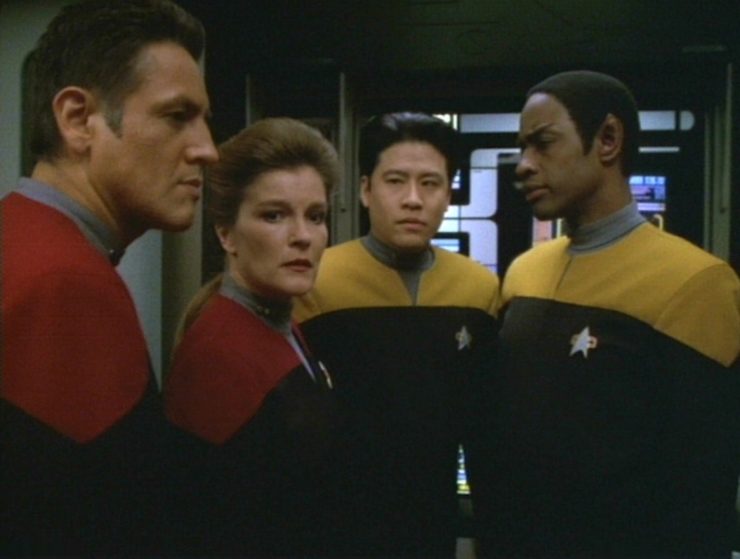
Janeway hits on an idea: an alliance with the Borg. Offer them the EMH’s method of fighting 8472’s disease in exchange for safe passage through Borg space. Only the EMH has it, and he can’t be assimilated. If the Borg try to assimilate them or betray them in any way, she’ll delete the EMH. (She assures a crestfallen doctor that it won’t come to that.)
Only after the rest of the senior staff leaves the meeting room does Chakotay raise his objections. He tells the fable of the scorpion and the fox (which is usually about a scorpion and a frog, but whatever): the scorpion asks the fox to take him across the river, and the fox refuses on the grounds that the scorpion will sting him. The scorpion insists he won’t and the fox swims across with him. The scorpion then stings the fox, which causes the fox to die and the scorpion to drown. When the dying fox points this out, the scorpion says, “It’s my nature.”
Chakotay thinks trusting the Borg—who have murdered so many people—is a spectacularly bad idea. But Janeway thinks it’s the only chance they have to make it home.
They approach the Borg. At first they’re ready to just assimilate, but when Janeway proposes her deal, they transport her to the cube. In mid-negotiation, however, 8472 attacks.
To be continued…
Can’t we just reverse the polarity? The Borg learn by assimilation, which means they know nothing about 8472, whom they can’t assimilate. However, the Voyager crew’s cruder means of research serves them well in this instance, because they can learn about 8472 through observation.
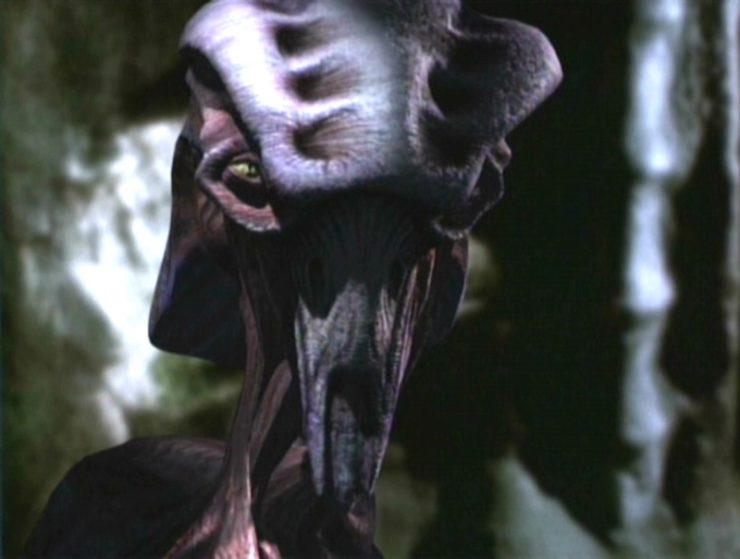
There’s coffee in that nebula! Janeway is completely focused on getting home, to the exclusion of all else, to the point where she considers making a deal with the Borg to be a viable option.
Please state the nature of the medical emergency. In the months since they took a Borg drone corpse on board, the EMH has been studying how assimilation works, and learns that nanotechnology is a big part of it. He comes up with a method of fighting 8472’s disease by using the nanoprobes the Borg use for assimilation.
Forever an ensign. Kim gets hit with 8472’s weapon. The disease is so virulent that the EMH can’t even sedate him.
Everybody comes to Neelix’s. Neelix has plenty of supplies, and has come up with ways to stretch out their existing food, given that resupply won’t be happening while they plow through Borg space.
No sex, please, we’re Starfleet. Chakotay tries to invite Janeway to dinner after mentioning that she hasn’t eaten or slept in days. She declines. Their private conversations modulate interestingly between captain and first officer and two confidants who know each other extremely well.
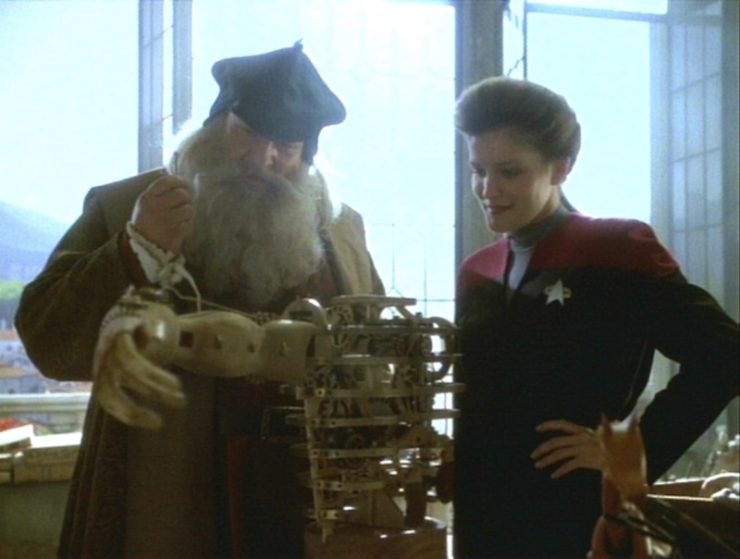
What happens on the holodeck stays on the holodeck. Janeway has re-created Leonardo da Vinci on the holodeck, and wants to spend her spare time apprenticing under him in a holographic medieval Florence. He takes some convincing, but he finally agrees to take her on. Later, staring at shadows on a wall in Leonardo’s studio gives her the idea of making the deal with the Borg.
Do it.
“Three years ago, I didn’t even know your name. Today, I can’t imagine a day without you.”
–Janeway being sappy at Chakotay.
Welcome aboard. The only guest is the great John Rhys-Davies playing a holographic Leonardo da Vinci. We’ll see him again in “Concerning Flight” in season four.
Trivial matters: This is Jennifer Lien’s last appearance in the opening credits of the show. She’ll make three more appearances, in “Scorpion, Part II” and “The Gift” in season four and “Fury” in season six, where she’ll be listed before the guest stars as “also starring.”
The notion of having Janeway visit Leonardo da Vinci on the holodeck came at least in part from Kate Mulgrew, who did significant research into Leonardo’s life to prepare for the scenes.
When Leonardo offers to take Janeway to Santa Croce to pray, I squeed a bit, as when my wife and I spent part of our honeymoon in Florence, we stayed half a block from Santa Croce. It was one of the best parts of a great honeymoon.
The novel Places of Exile by regular rewatch commenter Christopher L. Bennett in the collection Myriad Universes: Infinity’s Prism presents an alternate timeline that splits off from this episode: Janeway listens to Chakotay and doesn’t ally with the Borg, and Voyager instead settles down in the region of space between the Nekrit Expanse and Borg space, allying with the various local nations to form the Delta Coalition.
Janeway references Starfleet’s first encounter with the Borg in TNG’s “Q Who,” specifically mentioning Q tossing the Enterprise into the Delta Quadrant in that episode. She also mentions the Battle of Wolf 359 from TNG’s “The Best of Both Worlds, Part II” and DS9’s “Emissary.”
One of the captains Janeway quotes is Captain Amasov of the Endeavour, a tribute to the late science fiction grandmaster Isaac Asimov, best known for his fiction about robots (and who was also a friend of Gene Roddenberry’s). Amasov appears in two comics, the story “Loyalty” by F.J. DeSanto and Bettina Kurkoski in the TNG manga volume Boukeshin; and Alien Spotlight: Borg by Andrew Steven Harris and Sean Murphy. The former specifies that the Endeavour‘s encounter with the Borg was at Wolf 359, and that the Endeavour was the only ship to survive that battle.
The crew first encountered evidence of the Borg at the end of “Blood Fever,” and found a dead cube and brought the Borg corpse on board in “Unity.”
The needles used to insert nanoprobes into assimilation victims were first seen in the movie First Contact. Their specific function is explained here for the first time.
Janeway quotes Marshall McLuhan to Leonardo: “All invention is but an extension of the body of man.”
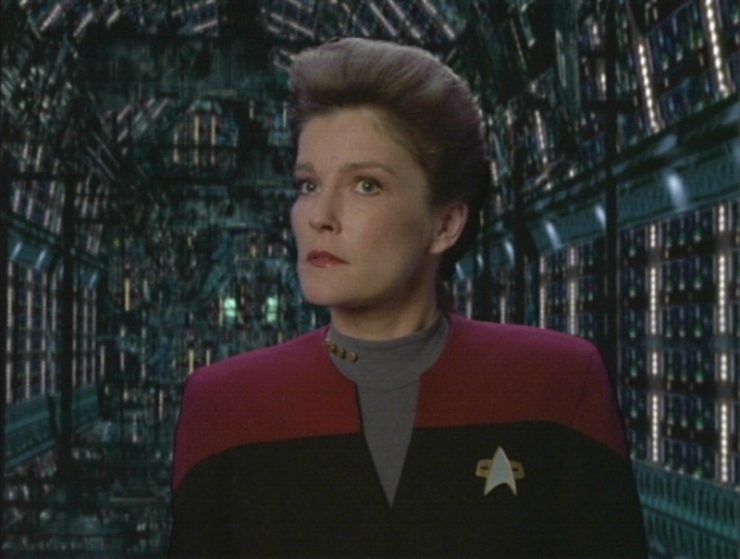
Set a course for home. “What if I made an appeal to the devil?” I want to like this episode a lot more than I actually do. I approached this particular rewatch with only vague memories of what happened in this season-spanning two-parter and I was very disappointed to get to the “To be continued…” caption to find that the only thing I remembered that was from this part was the teaser. Everything else I recalled happened in Part 2.
And that’s mostly because there’s only really about fifteen minutes’ worth of story here. Which is too bad, because there’s also some really really powerful stuff in this first part, there’s just not enough story for an hour.
The most common traps that two-parters fall into are to have Part 1’s that show great promise only to have Part 2 be a letdown (an issue that plagued all of TNG’s season-spanning cliffhangers), or to have Part 1’s that are all setup for Part 2 (TNG’s “Unification” especially had that problem).
“Scorpion” is most assuredly the latter. It starts out hugely promising, with one of the best teasers in Trek history: the Borg having their assimilation mantra interrupted by being blown to bits. That’s the first of three compelling visuals, beautifully filmed by director David Livingston and the special effects crew led by Ronald B. Moore, the other two being the fifteen cubes zooming past Voyager like bats out of hell without really stopping, and those same fifteen cubes blown to bits, in an eerie mirror of the Enterprise’s arrival at the Starfleet carnage at Wolf 359 in “The Best of Both Worlds, Part II.”
But so much time is spent talking about the Borg threat and worrying about the Borg threat and reading about the Borg threat. There’s also the mystery of Species 8472 (and seriously, they couldn’t come up with a better name for them?????), which is well played, and the aliens themselves are effective in their sensibly minimal screen time (given the limits of 1997 CGI).
The best part of the episode, though, is one of those talking scenes, because it’s one of the better arguments made on a Star Trek series, as Chakotay argues against making the deal with the Borg. Robert Beltran again delivers when given good material, and his argument is extremely compelling.
And that’s the real problem. I’m watching this scene, and I’m on Chakotay’s side, not Janeway’s. Making a deal with the devil is never a good idea, you always pay a high price for it.
Janeway’s motivations are confusing here. She wants to get everyone home, yes, but it’s only been on this level of obsession once before—in “The Swarm,” where all of a sudden, she was willing to violate a nation’s sovereign territory to shave fifteen months off the trip home. But aside from that, she’s had none of this urgency, and it’s kind of out of left field here.
Again, we’re talking about the Borg. These are the guys who introduced themselves to the Enterprise by killing eighteen people, who wiped out dozens of outposts along the Romulan border and the colony on Juret IV, who massacred the fleet at Wolf 359, and laid waste to the fleet at Earth just a few months prior to this (though Janeway is unaware of that last one). This is not who you make a deal with…
There’s some powerful stuff here, which sets up the second part—which we’ll deal with next week—and the rest of the series, truly.
Warp factor rating: 6
Keith R.A. DeCandido has been doing readings of his short fiction since the pandemic started. Check out his “KRAD COVID readings” YouTube channel which includes, among other things, his readings of his Star Trek short stories “Letting Go” (from the Voyager anthology Distant Shores), “Broken Oaths” (from the Deep Space Nine anthology Prophecy and Change), “loDnI’pu’ vavpu’ je” (from the Tales from the Captain’s Table anthology), and “Four Lights” (from the Next Generation anthology The Sky’s the Limit), as well as an excerpt from the Starfleet Corps of Engineers novella Here There Be Monsters. There’s a new reading every Monday, Wednesday, and Friday.










